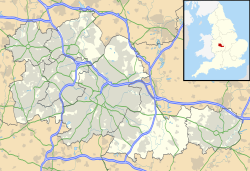 St Mary's Convent entrance | |
| Monastery information | |
|---|---|
| Full name | St Mary's Convent, Sisters of Mercy, Handsworth |
| Order | Sisters of Mercy |
| Established | 1840 |
| Dedicated to | Blessed Virgin Mary |
| Diocese | Birmingham |
| People | |
| Important associated figures | John Hardman |
| Architecture | |
| Heritage designation | Grade II* listed |
| Architect | Augustus Pugin |
| Site | |
| Location | Lozells, Birmingham, England |
| Coordinates | 52°29′53″N1°54′54″W / 52.4980°N 1.9150°W |
| Grid reference | SP0586488903 |
| Public access | Yes |
St Mary's Convent is a house for the community of the local Sisters of Mercy in Birmingham. Although it is situated between the Lozells and Hockley parts of the city, the community also serves the parish in Handsworth. It was founded in 1840 and was designed by Augustus Pugin. On 25 April 1952 it was designated as a Grade II* listed building by English Heritage. [1]



